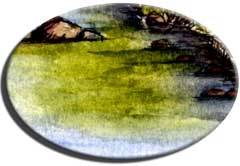Why are algae important?
 Algae comprise the base
of the food web in most stream ecosystems. Via photosynthesis they store energy that feeds many of the organisms that live in and around streams.
Algae are integral to gauging stream health both because they affect other life forms, and because they respond rapidly to changes in their environment,
particularly with respect to nutrients, organic pollution, acidity, physical disturbance, and salinity. Algae assessment is especially useful when
paired with other measures of stream health, such as assessment of benthic macroinvertebrates (bugs) because they complement bugs in terms of what
stressors affect them, the period of time over which they respond to changes, and potentially also in terms of the level of stress to which they
are most responsive.
Algae comprise the base
of the food web in most stream ecosystems. Via photosynthesis they store energy that feeds many of the organisms that live in and around streams.
Algae are integral to gauging stream health both because they affect other life forms, and because they respond rapidly to changes in their environment,
particularly with respect to nutrients, organic pollution, acidity, physical disturbance, and salinity. Algae assessment is especially useful when
paired with other measures of stream health, such as assessment of benthic macroinvertebrates (bugs) because they complement bugs in terms of what
stressors affect them, the period of time over which they respond to changes, and potentially also in terms of the level of stress to which they
are most responsive.
Algae can also be harmful. The introduction of nutrients, such as nitrogen and phosphorus, into our waterways can cause algae to grow rapidly, forming algal blooms. Too much algae in a stream, river, or lake can smother fish and other species. Some algal species release toxic chemicals called "biotoxins" that can harm or even kill other organisms.
How do we measure algae?
Biological health is measured in a variety of ways, but most focus on the abundance and type of species present. In the case of algae, total biomass (i.e., how much algae is present) is also an important indicator.

